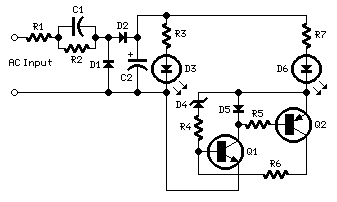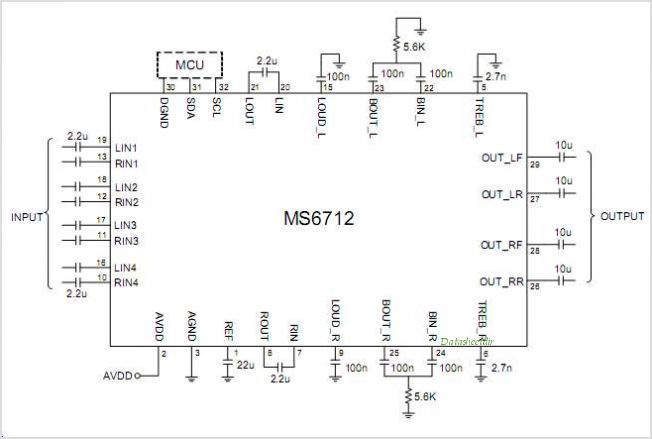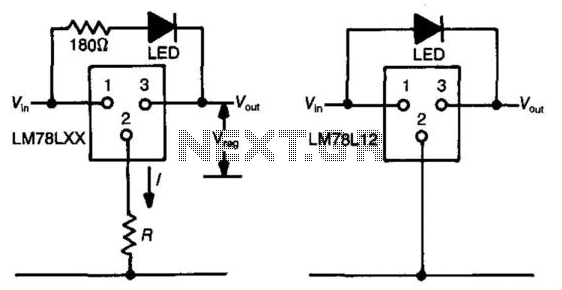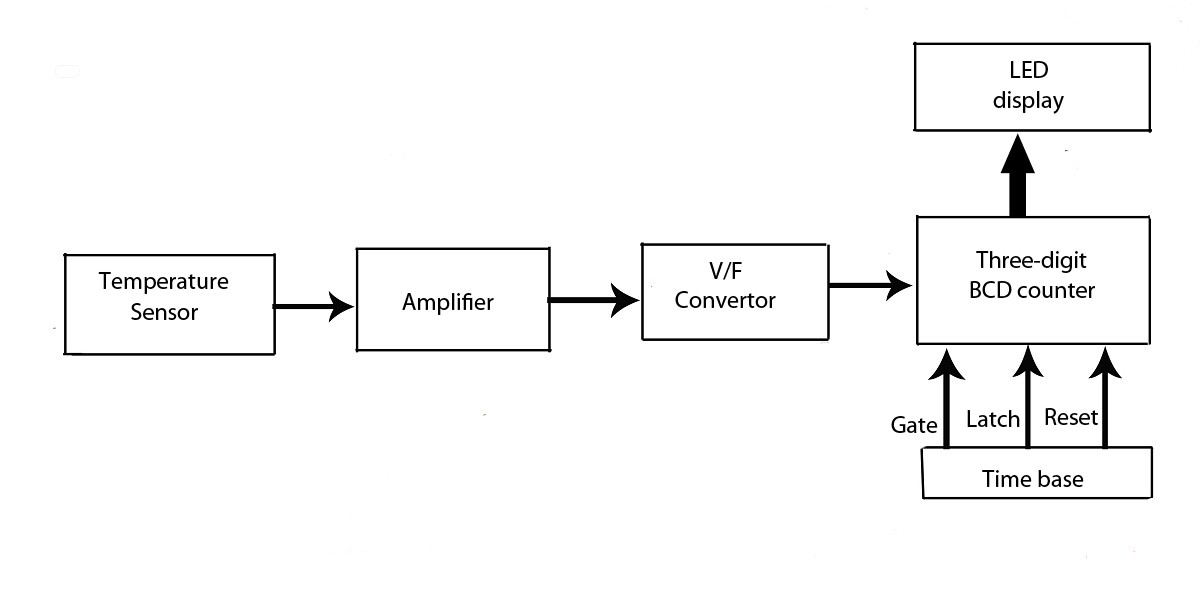
Balance Indicator

If an amplifier is equipped with two level controls, it provides both a balance control and a level control. A drawback of this configuration is the difficulty in accurately setting the balance. This issue can be resolved by replacing the two monopotentiometers with stereo versions P1 and P2 as illustrated in the diagram. One half of the pair, P1A and P2A, takes over the functions of the removed components, while the other half is arranged in a bridge circuit. The voltage between the wipers of the potentiometers indicates the balance between the two channels; a lower potential indicates better balance. To measure the degree of unbalance, a center-zero moving coil meter can be connected with a bias resistor between points A and B. In this setup, zener diodes D1 and D2 can be eliminated, as they are only necessary for the LED indicator shown in the diagram to prevent the input voltage of the operational amplifier from approaching the supply voltage. The circuit surrounding IC1 functions as a classical differential amplifier. Resistors R5 and R6 create a virtual ground for the LEDs, which is essential for obtaining both positive and negative outputs despite the asymmetrical supply voltage. The inclusion of the LEDs in the feedback loop of the indicator enhances the circuit's sensitivity; at just 40 mV, or 1/1000 of the supply voltage, one of the LEDs begins to illuminate. The maximum current drawn by the LEDs is controlled by the values of R5 and R6.
The described amplifier circuit utilizes a pair of stereo potentiometers (P1 and P2) to achieve both balance and level control. The configuration allows for a straightforward adjustment of the audio balance between two channels, with the bridge circuit providing a clear representation of the channel balance. The voltage measurement across the wipers of the potentiometers is crucial, as it directly correlates to the balance; thus, a lower voltage indicates a more balanced signal output.
In addition to the basic functionality, the integration of a center-zero moving coil meter enhances the user interface, allowing for a visual indication of the balance status. The bias resistor connected to the meter ensures accurate readings by establishing a reference point in the circuit. The removal of the zener diodes simplifies the design when the LED indicators are not required, streamlining the circuit while maintaining essential functionality.
The differential amplifier configuration using IC1 plays a pivotal role in processing the signals, with resistors R5 and R6 ensuring that the LEDs receive appropriate biasing to indicate the balance status effectively. The virtual ground created by these resistors allows the circuit to operate correctly with an asymmetrical power supply, which is common in many audio applications. The sensitivity of the circuit is particularly noteworthy; the ability to light the LEDs at a mere 40 mV demonstrates the precision of the design, making it suitable for applications where fine-tuning of audio levels is critical.
Overall, this circuit design exemplifies a robust solution for achieving balance control in audio amplifiers, providing both functional and visual feedback to the user while maintaining simplicity and effectiveness in operation. If your amplifier is fitted with two level controls, it actually offers you a balance control and a level control. A draw back of this is that it is quite difficult to set the balance properly. This can be obviated, however, by replacing the two monopotentiometers with stereo versions PI and P2 in the diagram. One half of the pair, P1A and P2A, assumes the tasks of the removed components. The other half Is connected in a bridge circuit. The voltage between wipers of the potentiometers is then a measure of the balance between the two channels.
The lower the potential, the better the balance. If you are interested in knowing the degree of unbalance, connect a center-zero moving coil meter with a bias resistor between A and B. With this arrangement, zener diodes Dl and D2 can be omitted: they are necessary only with the LED indicator shown in the diagram to prevent the input voltage of the op amp from getting too close to the level of the supply voltage.
The circuit around IC1 is a classical differential amplifier. Resistors R5 and R6 provide a virtual earth for the LEDs, which is necessary to ensure that, in spite of the asymmetrical supply voltage, a positive and a negative output is obtained. Because the LEDs have been included in the feedback loop of the indicator, the circuit is pretty sensitive.
At only 40 mV, that is, just 1Uoo of the supply voltage, one of the LEDs begins to light. The maximum current drawn by the LEDs is determined by the values of R5 and R6. 🔗 External reference
The described amplifier circuit utilizes a pair of stereo potentiometers (P1 and P2) to achieve both balance and level control. The configuration allows for a straightforward adjustment of the audio balance between two channels, with the bridge circuit providing a clear representation of the channel balance. The voltage measurement across the wipers of the potentiometers is crucial, as it directly correlates to the balance; thus, a lower voltage indicates a more balanced signal output.
In addition to the basic functionality, the integration of a center-zero moving coil meter enhances the user interface, allowing for a visual indication of the balance status. The bias resistor connected to the meter ensures accurate readings by establishing a reference point in the circuit. The removal of the zener diodes simplifies the design when the LED indicators are not required, streamlining the circuit while maintaining essential functionality.
The differential amplifier configuration using IC1 plays a pivotal role in processing the signals, with resistors R5 and R6 ensuring that the LEDs receive appropriate biasing to indicate the balance status effectively. The virtual ground created by these resistors allows the circuit to operate correctly with an asymmetrical power supply, which is common in many audio applications. The sensitivity of the circuit is particularly noteworthy; the ability to light the LEDs at a mere 40 mV demonstrates the precision of the design, making it suitable for applications where fine-tuning of audio levels is critical.
Overall, this circuit design exemplifies a robust solution for achieving balance control in audio amplifiers, providing both functional and visual feedback to the user while maintaining simplicity and effectiveness in operation. If your amplifier is fitted with two level controls, it actually offers you a balance control and a level control. A draw back of this is that it is quite difficult to set the balance properly. This can be obviated, however, by replacing the two monopotentiometers with stereo versions PI and P2 in the diagram. One half of the pair, P1A and P2A, assumes the tasks of the removed components. The other half Is connected in a bridge circuit. The voltage between wipers of the potentiometers is then a measure of the balance between the two channels.
The lower the potential, the better the balance. If you are interested in knowing the degree of unbalance, connect a center-zero moving coil meter with a bias resistor between A and B. With this arrangement, zener diodes Dl and D2 can be omitted: they are necessary only with the LED indicator shown in the diagram to prevent the input voltage of the op amp from getting too close to the level of the supply voltage.
The circuit around IC1 is a classical differential amplifier. Resistors R5 and R6 provide a virtual earth for the LEDs, which is necessary to ensure that, in spite of the asymmetrical supply voltage, a positive and a negative output is obtained. Because the LEDs have been included in the feedback loop of the indicator, the circuit is pretty sensitive.
At only 40 mV, that is, just 1Uoo of the supply voltage, one of the LEDs begins to light. The maximum current drawn by the LEDs is determined by the values of R5 and R6. 🔗 External reference





